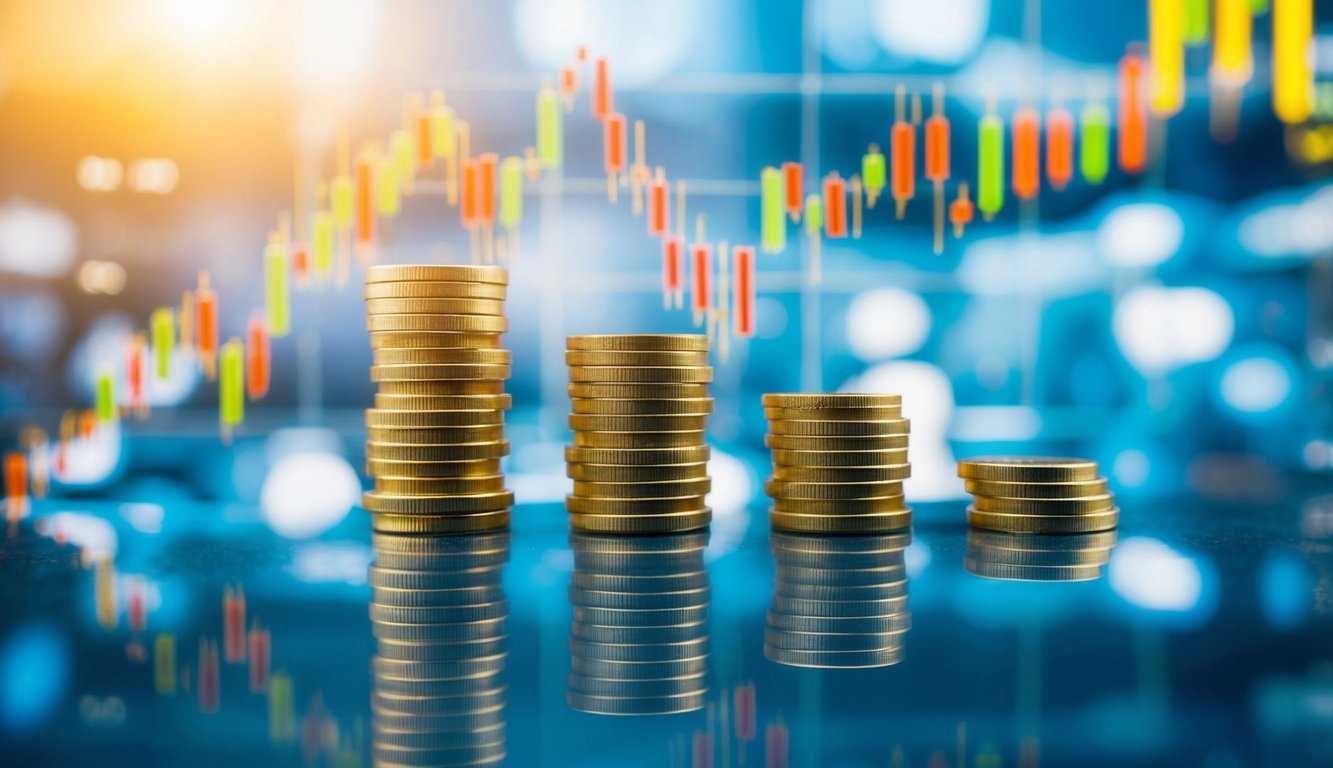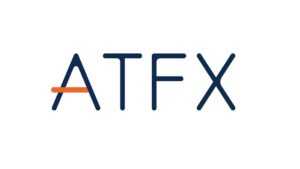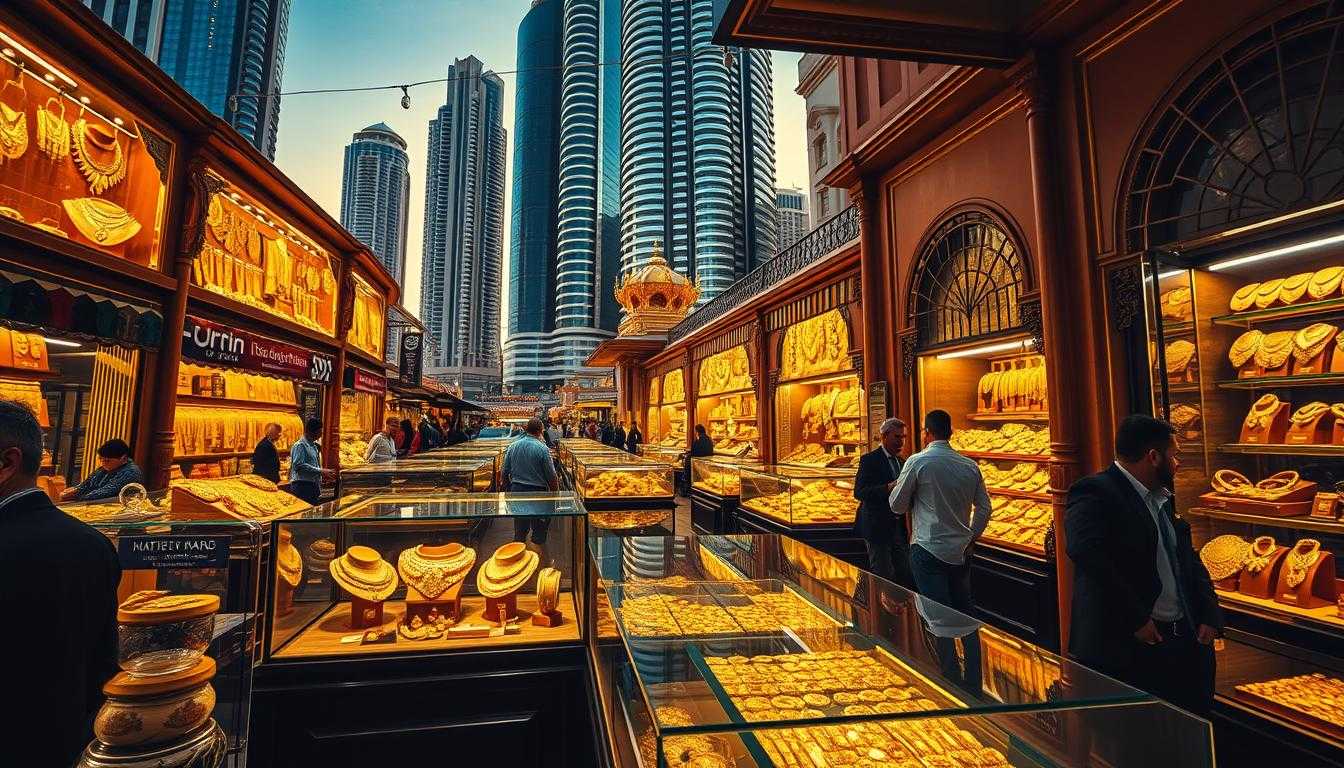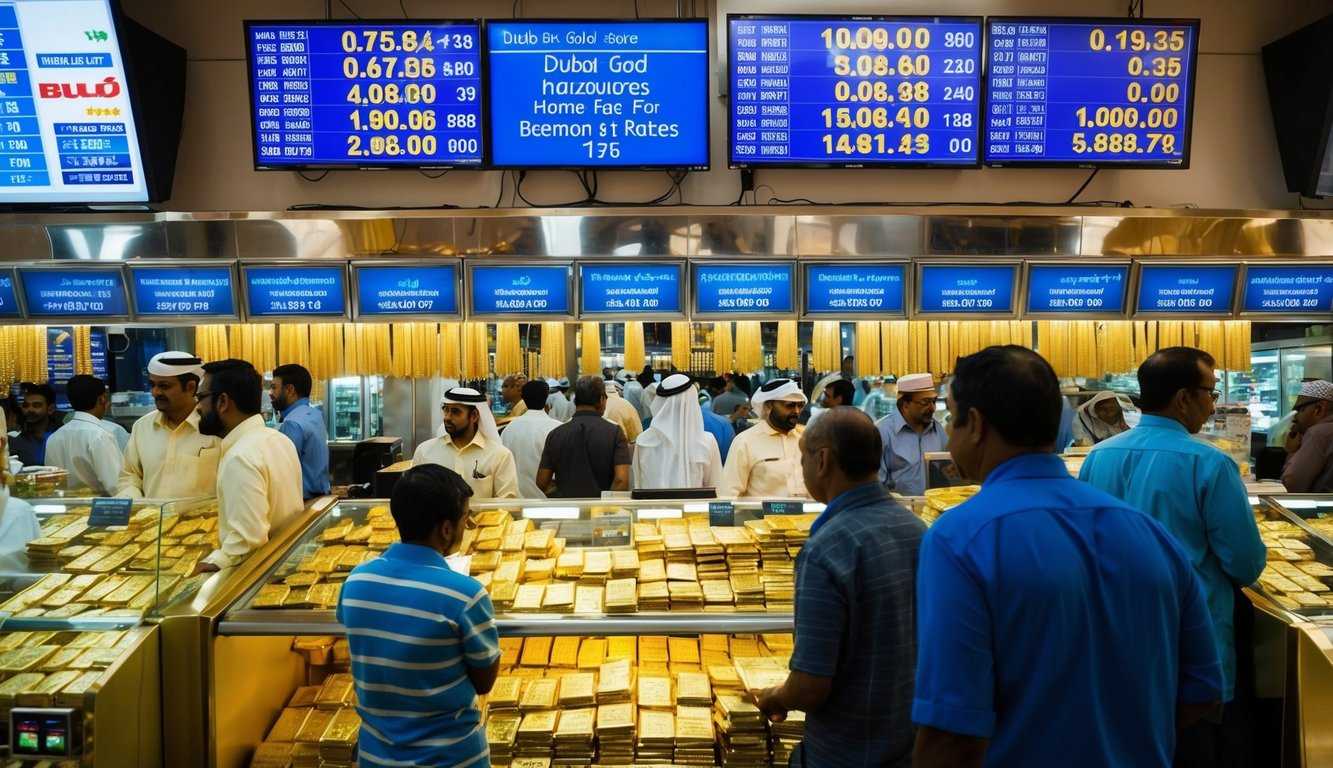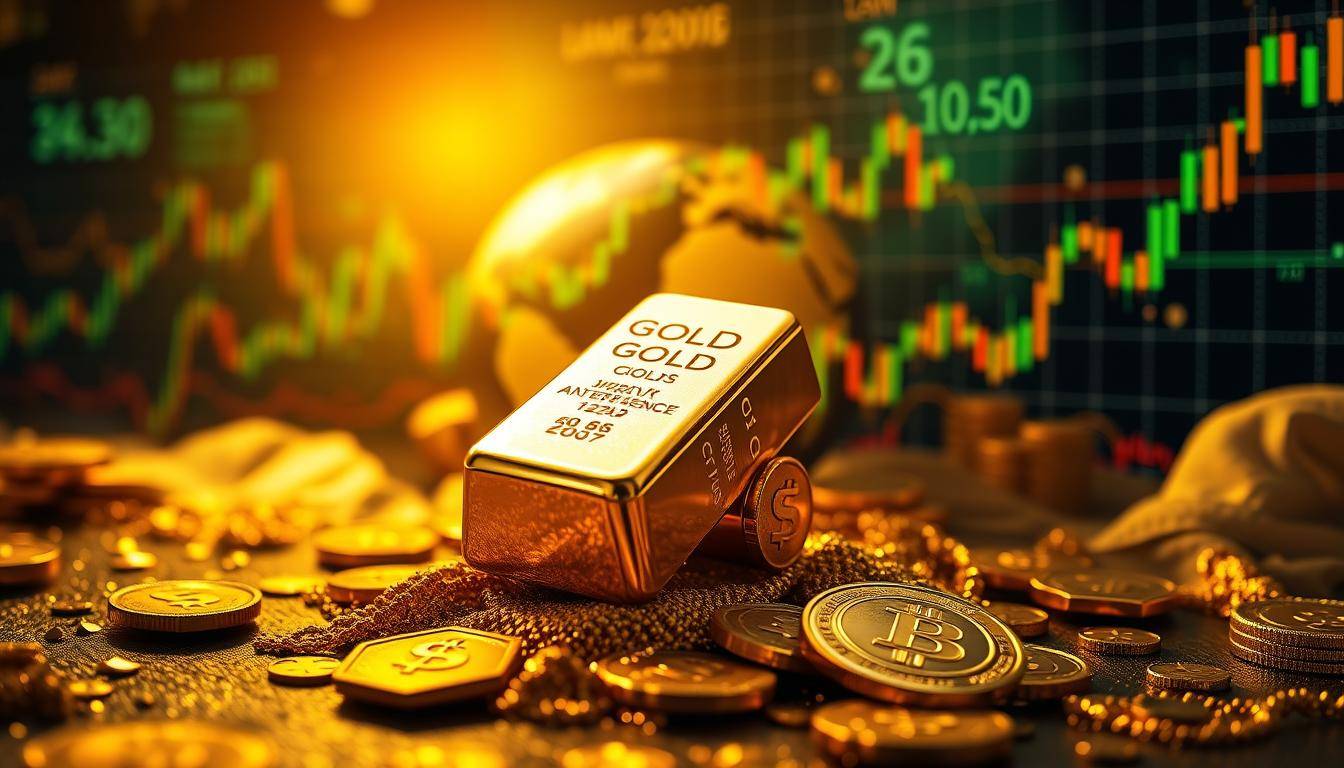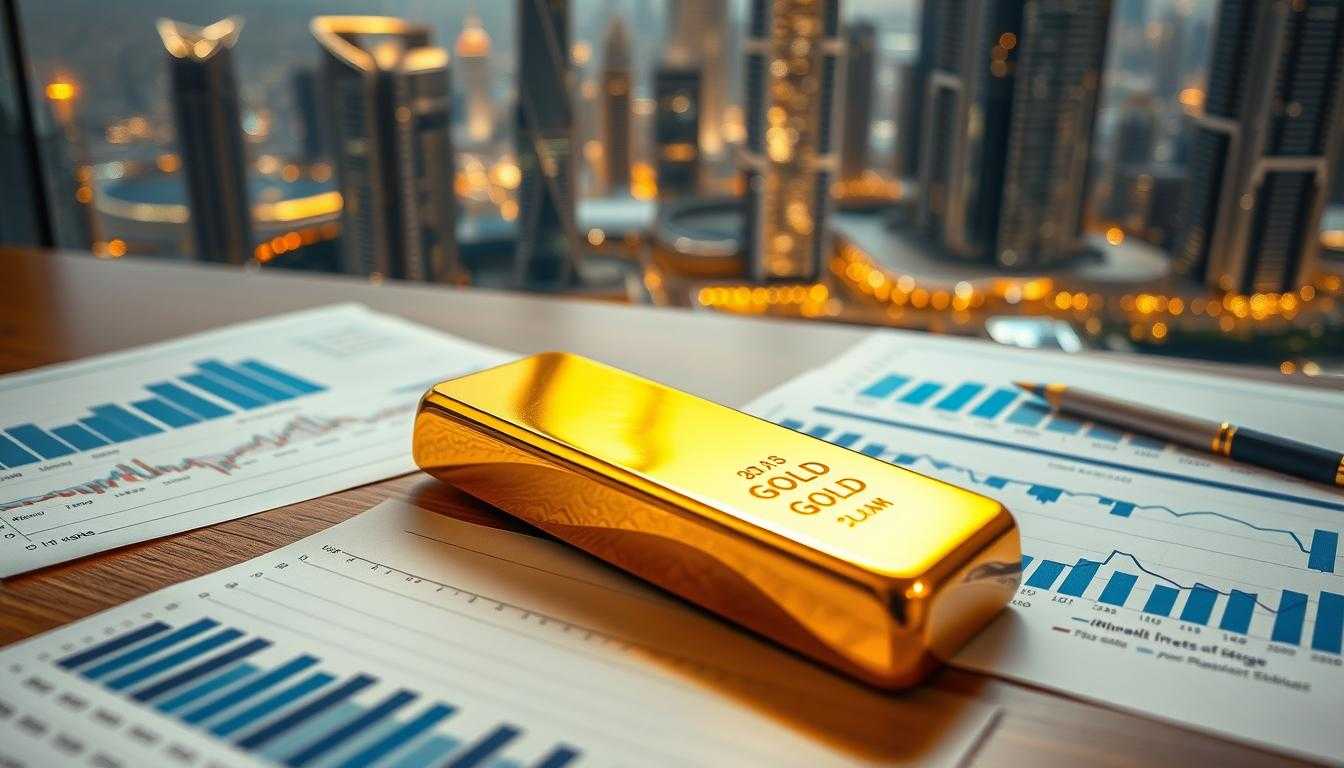Gold prices change every day due to many factors. These changes affect investors and traders in the gold market. The price of gold is shaped by supply and demand, economic indicators, and global events.

Interest rates play a big role in gold pricing. When rates go up, the value of gold often goes down. This is because people may choose to invest in other options that offer better returns. In 2022, central banks raised rates, which led to a drop in gold prices.
The strength of currencies also impacts gold. A strong U.S. dollar usually means lower gold prices. This is because gold is priced in dollars, making it more expensive for buyers using other currencies. Inflation and geopolitical events can cause people to see gold as a safe investment, driving up its price.
Key Takeaways
- Gold prices are influenced by supply and demand, economic factors, and world events
- Interest rates and currency values have a significant impact on gold prices
- Investors often turn to gold as a safe option during times of economic uncertainty
- Open your account now with ICM Capital and trade Live on Gold with a global broker who holds international licenses and authorized by the Abu Dhabi Global Market UAE.
- Open your account now with Equiti and trade Live on Gold with a global broker who holds international licenses and authorized by Securities and Commodities Authority of the UAE.
The Role of Supply and Demand in Gold Pricing

The gold market is driven by the interplay of supply and demand. These forces shape gold prices daily, with shifts in either side causing ripples across the market.
Gold Production and Mining Influences
Gold production plays a big role in supply. Mining companies extract gold from the earth, but this process is costly and time-consuming. New gold discoveries are rare, which limits the amount of gold added to the market each year.
Gold mines face challenges like:
- High operating costs
- Environmental regulations
- Political instability in some regions
These factors can slow down production or make it more expensive. When supply tightens, prices often rise if demand stays steady or increases.
Investment Demand and Gold Jewelry Consumption
On the demand side, we see two main drivers: investment and jewelry. Investors buy gold as a safe haven during uncertain times. This can cause quick price jumps when world events spark worry.
Jewelry is a steady source of gold demand. In many cultures, gold jewelry is a sign of wealth and status. India and China are big buyers of gold for this purpose.
Investment demand can change fast. People might rush to buy gold if:
- The stock market drops
- A currency loses value
- Political tensions rise
Jewelry demand is more stable but can shift with economic changes. When people have more money, they tend to buy more gold jewelry.
⇒ Open your account now with ICM Capital and trade Live on Gold with a global multi-regulated broker and authorized by the Abu Dhabi Global Markets (ADGM) ⇐
Economic Indicators Impacting Gold Value

Gold prices respond to various economic factors. These indicators shape the precious metal’s value in complex ways.
Interest Rates and Their Effect on Gold
Interest rates play a big role in gold prices. When rates go up, gold often becomes less attractive. This is because gold doesn’t pay interest. Higher rates make bonds and savings accounts more appealing.
Low interest rates can boost gold prices. Investors may turn to gold when they can’t get good returns elsewhere. The Federal Reserve’s decisions on rates are crucial for gold markets.
We see this link clearly in market trends. Gold prices tend to move opposite to interest rate changes.
Central Banks’ Monetary Policies
Central banks influence gold prices through their policies. They can buy or sell large amounts of gold. This affects supply and demand in the market.
When central banks increase gold reserves, it can push prices up. Their actions signal confidence or concern about the economy. Investors watch these moves closely.
Quantitative easing policies can also impact gold. When banks print more money, it can lead to inflation fears. This often makes gold more valuable as a safe haven.
Inflation and Gold as a Store of Value
Gold is seen as a hedge against inflation. When prices for goods and services rise, gold often keeps its value. This makes it a popular choice in times of high inflation.
Investors buy gold to protect their wealth from losing purchasing power. As the dollar’s value drops, gold prices tend to go up. This relationship isn’t perfect, but it’s a common trend.
Gold’s limited supply adds to its appeal during inflation. Unlike paper money, we can’t just print more gold. This scarcity helps it maintain value over time.
⇒ Open your account now with ICM Capital and trade Live on Gold with a global broker who holds international licenses and is authorized by the Abu Dhabi Global Market UAE
⇒ Open your account now with Equiti and trade Live on Gold with a global broker who holds international licenses and is authorized by Securities and Commodities Authority of the UAE.
Gold and Currency Valuations

Gold prices and currency values are closely linked in the global financial markets. Changes in one often affect the other, creating a complex relationship that investors watch closely.
Correlation Between the U.S. Dollar and Gold
The U.S. dollar and gold prices typically move in opposite directions. When the dollar weakens, gold often becomes more expensive. This happens because gold is priced in dollars worldwide. A weaker dollar means it takes more dollars to buy the same amount of gold.
Open your account now with ICM Capital and trade Live on Gold with a global broker who holds international licenses and authorized by the Abu Dhabi Global Market UAE. Similarly, you can open your account now with Equiti and trade Live on Gold with a global broker who holds international licenses and authorized by Securities and Commodities Authority of the UAE.
The U.S. Dollar Index is a key tool for tracking this relationship. It measures the dollar’s strength against a basket of major currencies. When the index falls, gold prices tend to rise.
Investors often turn to gold when they lose faith in paper currencies. This can drive up gold prices even further.
Gold as a Hedge Against Currency Devaluation
Gold is seen as a safe haven during times of economic uncertainty. When governments print more money, it can lead to inflation and currency devaluation. This makes each unit of currency worth less.
In these situations, many investors buy gold to protect their wealth. They believe gold will hold its value better than paper money.
Gold’s limited supply adds to its appeal. Unlike currencies, central banks can’t simply create more gold. This scarcity helps gold maintain its value over time.
We’ve seen this play out in countries experiencing severe economic crises. As local currencies lose value, citizens often rush to buy gold as a store of wealth.
Market Dynamics and Investment Strategies
Gold markets are complex and influenced by many factors. Smart investors look at futures, volatility, and how gold fits into their overall plans.
Assessing Gold Futures and Volatility
Gold futures help investors predict future prices. These contracts let buyers and sellers agree on a price for gold delivered later. Futures prices change based on market conditions.
Volatility in gold prices can be high at times. This means big swings up or down. Some causes of volatility are:
- Economic news
- Political events
- Changes in supply and demand
Tracking volatility helps us understand market trends. It’s key for timing buys and sells.
Diversifying with Gold in an Investment Portfolio
Gold can be a useful part of a balanced investment mix. It often moves differently from stocks and bonds. This can help spread out risk.
Ways to add gold to a portfolio:
- Physical gold (coins, bars)
- Gold ETFs
- Gold mining stocks
The amount of gold to hold depends on each person’s goals and risk comfort. Some experts suggest 5-10% of a portfolio in gold.
Gold is seen as a safe-haven asset. This means people often buy it when other investments look risky.
“Open your account now with ICM Capital and trade Live on Gold with a global broker who holds international licenses and authorized by the Abu Dhabi Global Market UAE.”
“Open your account now with Equiti and trade Live on Gold with a global broker who holds international licenses and authorized by the Securities and Commodities Authority of the UAE.”
Understanding Liquidity and Opportunity Cost in Gold Investments
Liquidity means how easy it is to buy or sell an asset. Gold is generally quite liquid. You can trade it in many forms around the world.
Physical gold can be less liquid than gold-backed securities. It may take time to find a buyer for coins or bars.
Opportunity cost is what we give up by choosing one investment over another. With gold, we might miss out on:
- Dividend income from stocks
- Interest from bonds
Gold doesn’t produce income on its own. Its value comes from price changes over time. We need to weigh this against other investment options.
External Factors Influencing the Gold Market
Gold prices react strongly to events beyond our control. These outside forces can cause big swings in the precious metal’s value.
Economic Uncertainties and Geopolitical Events
Economic turmoil often drives investors to gold as a safe haven. During recessions or financial crises, people lose faith in traditional assets. This pushes up demand for gold. The 2008 financial crash saw gold prices soar as stocks tumbled.
Wars and political tensions also impact gold. The Gulf War in 1990 and the 9/11 attacks in 2001 both caused gold prices to jump. Investors see gold as protection during unstable times.
Central bank policies play a big role too. When interest rates rise, gold often falls as other investments become more attractive. But if inflation fears grow, gold typically gains value.
Impact of Natural Disasters on Precious Metals
Natural disasters can disrupt gold mining and supply chains. This can lead to short-term price spikes. Earthquakes or floods in major gold-producing regions may halt production.
But disasters can also lower gold prices. If a catastrophe damages the economy, people might sell gold to cover losses. The 2011 Japan earthquake initially caused gold to drop as investors sold to raise cash.
Long-term effects vary. Some disasters boost gold as part of wider economic uncertainty. Others have little lasting impact on the market.
⇒ Open your account now with ICM Capital and trade Live on Gold with a global multi-regulated broker and authorized by the Abu Dhabi Global Markets (ADGM) ⇐
Frequently Asked Questions
Gold prices are influenced by many factors. Let’s look at some common questions about what affects gold rates and market dynamics.
What factors contribute to the fluctuation of gold prices?
Supply and demand play a big role in gold prices. When more people want to buy gold, the price goes up. Other factors include economic conditions, interest rates, and geopolitical events. Market speculation can also cause short-term price swings.
How does inflation impact the value of gold?
Gold is seen as a hedge against inflation. When inflation rises, the purchasing power of currency drops. This often leads investors to buy gold as a way to protect their wealth. As a result, gold prices tend to increase during times of high inflation.
In what ways do global economic trends affect gold market dynamics?
Economic growth can impact gold in different ways. Strong economies may reduce gold demand as investors seek higher-yield assets. But economic uncertainty can increase gold’s appeal as a safe haven. Global trade tensions or financial crises can also drive up gold prices.
What is the relationship between the US dollar and gold prices?
Gold and the US dollar often move in opposite directions. When the dollar weakens, gold becomes cheaper for buyers using other currencies. This can boost demand and push up gold prices. A stronger dollar tends to have the opposite effect on gold rates.
Why do gold prices sometimes experience a sudden drop?
Sharp drops in gold prices can happen for various reasons. Large sell-offs by major holders, positive economic news, or rising interest rates can trigger quick price declines. Market corrections after periods of rapid price increases are also common.
What are the predictive indicators for future gold price movements?
We look at several indicators to gauge potential gold price trends. These include inflation rates, currency movements, central bank policies, and geopolitical tensions. Technical analysis of price charts and trading volumes can also offer clues about future price directions.

